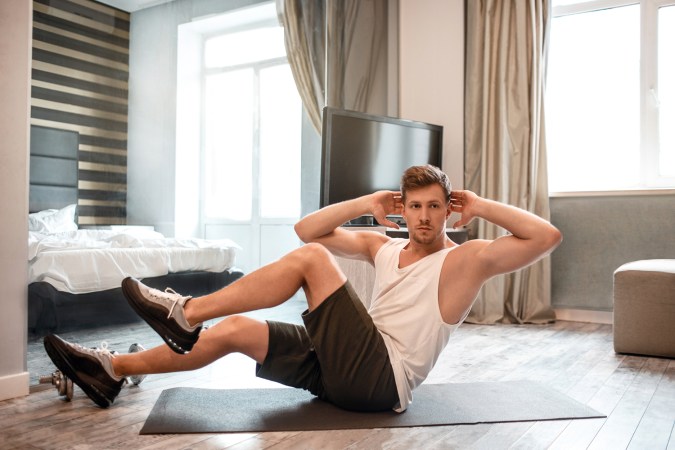

When you end your at-home workday, your commute is probably just 10 steps to the couch and television; maybe a quick detour to the snack cabinet. This can be a recipe for disaster, at least when it comes to fitness. Gone are the days of walking around the office on a sunny afternoon, meeting with coworkers, or even strolling across the office to chat with your boss. Instead, Zoom meetings blend together, one after the next, and before you know it you haven’t left your workspace, or even stood up, for more than a few minutes all day.
You’re not alone: Around 30 percent of people who exercised during the pandemic did so at lower intensities, and the same percentage shortened the length of their workouts. Comparatively, only 9 percent upped the intensity and 24 percent spent more time moving. Maybe we were all focused on trying to get groceries without contracting the virus. Maybe we had less access to our usual gyms and exercise programs. Maybe our workout buddies couldn’t make it, decreasing motivation. These are just some of the reasons people working from home might struggle to get moving, according to Brooke Burke, founder and CEO of Brooke Burke Body, a digital workout service available from mobile apps and some streaming platforms.
Surpassing these challenges means changing how you think about health and wellness and using equipment you already own in an efficient amount of time, Burke says. She has led barre classes using kitchen counters, and exercise programs based on sitting in an office chair, but you can use whatever you have available. With a little creativity and flexible thinking, you can easily turn the disadvantages of working from home into advantages.
Rethink your definition of “gym equipment”
In the “before times,” you might have worked out at an actual gym with large sets of free weights, exercise machines, mats, benches, tall mirrors, trainers, and cardio equipment. When you look around your home office and don’t have access to most (or any) of this, you might think you can’t make a true at-home workout happen. Plus, you’re not paying for a membership to work out at home, so the added motivation of getting your money’s worth may be non-existent.
[Related: How to keep your home workout space from smelling like a gym]
But water bottles, chairs, kitchen counters, and anything else can easily take the place of free weights, balance bars, and steps, Burke says. Even the weight of your own body and others in the house can stand in for hunks of cold metal. “I’ve done stretch-and-connect workouts in the morning, a little wake-up workout in bed,” she says. “Couples yoga utilizing each others’ body weight is really fun for families.”
Chop up your workout into three doable mini sessions
Gone are the days, for many, of that commute to and from an in-person gym, with a one-hour block of time to work out. Instead, we have an opportunity, says Kaitlyn Gannon, a personal trainer and owner of Svelte Performance, a strength and conditioning gym in Dallas. We can sneak three 10-minute workouts into our work-from-home day, adding up to the recommended half-hour per day. Filling the 15 minutes between video calls with a five-minute snack or bathroom break and 10 minutes of movement might make you much less likely to doze off during your next meeting, at the very least. Gannon recommends choosing three different styles of workouts with intention for each 10-minute window.
The first 10-minute session: the warmup
Sometime early in your day when you have a 10-minute window, you can try a warmup circuit that aims to raise your heart rate to half of your maximum heart rate (calculated by subtracting your age from 220). This can include gentle floor movements such as yoga, mobility, or corrective exercises, Gannon explains, or you might include some exercise bands (if you don’t have any, you can use your body weight). If you’re not sure what to do first, try out a yoga or stretching app for some bite-size routines. Even some simple pushups can do the trick, Gannon says.
The second 10-minute session: full-body training
A few hours later, or at your next break, use another 10 minutes to get your blood pumping, working toward 60 or 70 percent of your max heart rate, Gannon says. If you have dumbbells, you can break them out; if not, you can substitute items such as water bottles or potato sacks from your pantry.
This time period is best spent doing a full-body workout, she explains. Try to vary your approach from day to day, too: If you do a squat with an upper-body press one day, consider doing lower- or upper-body pulls the next. Use the weights as your resistance or as part of a high-intensity interval training (HIIT) workout, she says. One move she likes is called a “good morning”: Put a dumbbell against your upper back, or your hands behind your head with your chest up, and place your feet no wider than your hips. Stand near a wall and hinge your hips back (butt to the wall) to work your glutes and hamstrings. You can add bands if you have them.
The third 10-minute session: sunshine and cardio
Chances are, in your work-from-home rut, simply going outside has slipped your mind or fallen to the end of the priority list behind a seriously crowded inbox. Whether you are moving or not, 17 minutes outside per day can improve your health. Combine the two for even more powerful results.
Gannon says we can forget miles, calories, and trackers, and just head to the sidewalk, counting the houses as our metric. “Do three-house sprints…sprint down, walk back, or jog back, depending on what your recovery is and your level. If you want to do a 100 percent-out max sprint, you might just do one-and-a-half houses,” she says, though these numbers may change depending on your neighborhood’s layout. If you want to focus more on distance, maybe pick four or five houses. Walking at a brisk pace can accomplish a similar effect as running, depending on your fitness level. No matter what you do, work toward 80 to 90 percent of your max heart rate, Gannon explains.
Some advice for integrating the mini sessions
What you do not want to do, Gannon warns, is to go right from an all-out sprint back into your comfy chair. Doing so doesn’t allow your muscles to cool down or oxygen to flow through your body in the recovery process. “You want to get your heart rate back to resting and then sit down,” she says. Attend your next meeting while standing or walking, by simply placing your computer on a counter and pacing around a bit. “Try to stay up and moving as much as possible, like you would in an office,” she says, explaining that the half-hour of exercise plus this additional movement will lead to an hour total workout in the end.
Burke recommends wearing athletic pants—a style work-from-homers have already mastered—and keeping a work shirt nearby to change in and out of easily between meetings and exercise sessions. Or not, because it would really make work-from-home life more interesting if we periodically saw people doing three-house sprints in their blazers and pajama shorts.















